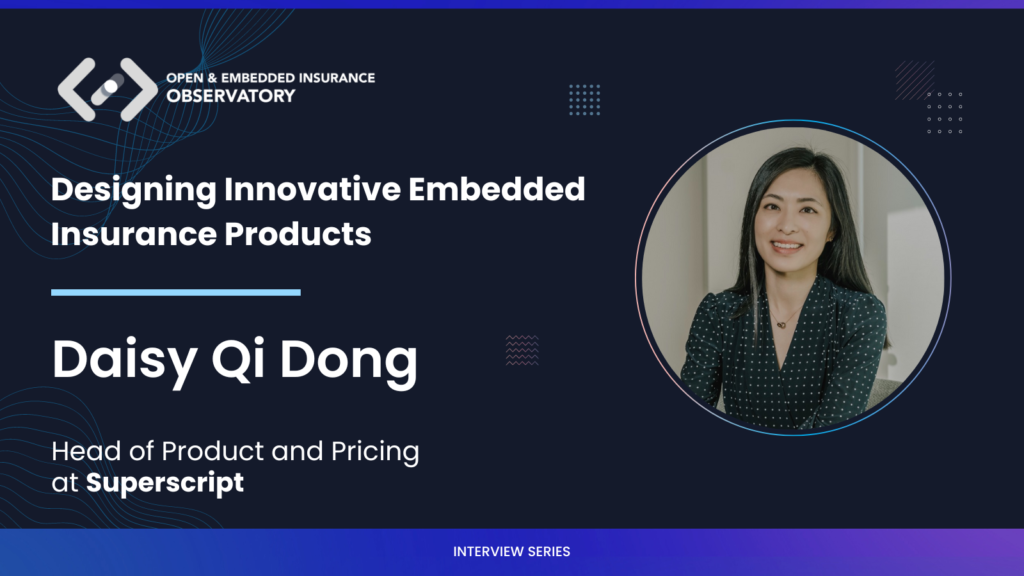In this conversation Daisy Qi Dong, Head of Product and Pricing, Europe at bolttech, and Yuri Poletto, CEO and Founder of Open and Embedded Insurance Observatory, discuss the unique strategies required to create embedded insurance offerings tailored to non-insurance brands and their customers.
Yuri Poletto: How do the product design and pricing logic are different in an embedded insurance market where you deal with non-insurance brands, compared with the traditional scenario where you deal with agents and brokers?
Daisy Qi Dong: Unlike traditional insurance agents and broker distribution channels, which often cater to customers who are already aware of their insurance needs and typically request standard products, embedded insurance distributed by non-insurance brands requires a distinct approach in product design and pricing.
The cornerstone of embedded insurance product design lies in the strategic utilisation of the core product offerings of non-traditional insurance distributors. This involves tailoring insurance products to seamlessly integrate with the existing offerings of these distributors, thereby enhancing contextuality and relevance. For example, for telcos and device retailers, offering device insurance aligns intuitively with their core business, whereas propositions like car insurance might not resonate as strongly.
Furthermore, in the embedded insurance landscape, the design of products must align with the distribution journey of the core product. This necessitates the creation of insurance products that are not only easy to comprehend but also seamlessly compatible with the purchasing process of the core product. Simplified language, intuitive interfaces, and seamless integration within the purchasing journey are paramount.
Moreover, pricing strategies in embedded insurance must be carefully calibrated to complement the pricing levels of the core products. Achieving compatibility in pricing is crucial for ensuring consumer acceptance and enhancing the perceived value proposition of the bundled offering. Therefore, pricing models need to be flexible and adaptable, accounting for factors such as consumer demographics, risk profiles, and the competitive landscape.
In essence, success in the embedded insurance market hinges on the ability to align product design and pricing strategies with the unique characteristics and distribution channels of non-insurance brands, ultimately delivering enhanced value and relevance to consumers
Yuri Poletto: What do you think are the biggest opportunity and the biggest challenge for companies operating in your market in the coming years?
Daisy Qi Dong: One of the most significant opportunities in the embedded insurance landscape lies in leveraging the strong customer relationships that distribution partners have cultivated through their core product and service offerings. By tapping into the insights gleaned from these ongoing engagements, insurance providers can pinpoint specific protection needs within the appropriate customer segments precisely when they arise. Moreover, this approach allows for the seamless offering of relevant insurance products at competitive prices, enriching the customer journey and driving increased adoption and satisfaction.
Embedded insurance encounters several challenges, with two significant ones being complex regulatory landscapes and stringent risk appetites from reinsurers and traditional insurers:
- Embedded insurance thrives on partnerships across various industries, offering opportunities for innovative product integration. However, this also means that companies must navigate through multiple legal and regulatory frameworks, each with its own requirements and standards. This complexity can sometimes lead to compromises in product design and hinder the seamless curation of the customer journey, limiting the full realisation of the product’s potential.
- Another challenge arises from the risk appetite and operational procedures of traditional insurers and reinsurers, whose involvement is often critical in the embedded insurance value chain. These entities may have well-established risk management frameworks and conservative approaches to underwriting, which can slow down the process of launching new or tailored products.
Yuri Poletto: What are your expectations for this plenary session?
Daisy Qi Dong: Open and Embedded Insurance Observatory Plenary Meeting presents a unique opportunity to engage with experts from diverse industries and markets in person. I’m super excited about the prospects of discussing emerging trends and gaining valuable insights into the evolving landscape of embedded insurance
Daisy will also be speaking at Open and Embedded Insurance Observatory Plenary Meeting 2024 on 19 March 2024. Find more details here: https://openinsuranceobs.com/plenary-meeting-london-2024/



